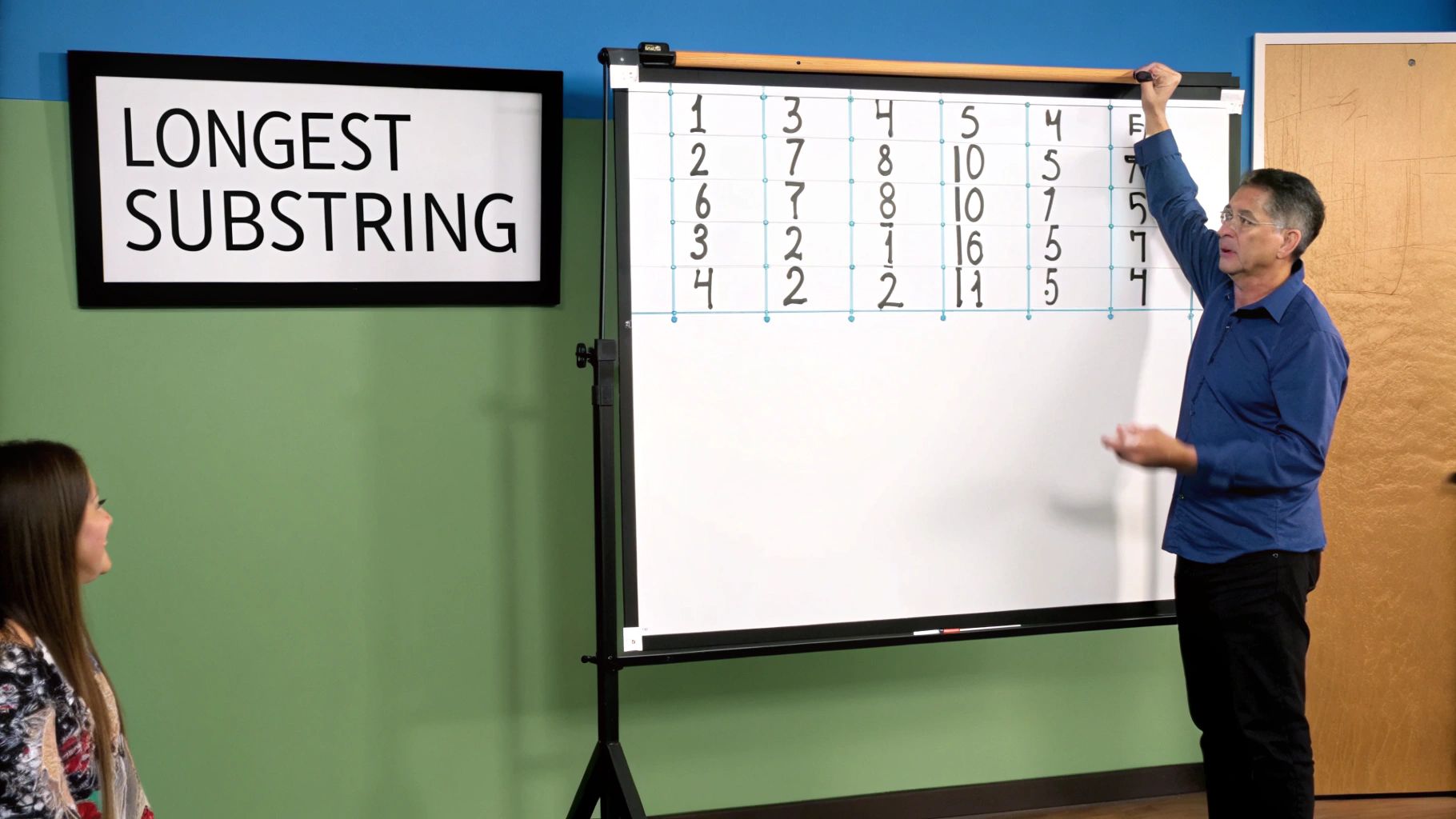Amazon Interview Programming Questions: Top 10 Tips for 2025

Navigating the technical interview process at Amazon requires more than just a surface-level understanding of algorithms and data structures. It demands a deep, practical knowledge of core computer science concepts and the ability to apply them under pressure. This guide is designed to cut through the noise and provide a focused, actionable roadmap for your preparation. We will dissect some of the most frequently encountered amazon interview programming questions, offering not just solutions, but a comprehensive breakdown of the underlying principles.
For each problem, you'll find a clear problem statement, an in-depth explanation of the optimal solution, and a step-by-step implementation in a common programming language. We'll explore the "why" behind each approach, analyzing time and space complexity and discussing alternative strategies. The goal is to equip you with a problem-solving framework that extends beyond memorization, enabling you to tackle unfamiliar challenges with confidence.
Success in these interviews isn't just about getting the right answer; it's about demonstrating your thought process and engineering discipline. Beyond finding a correct solution, demonstrating your ability to write clear, maintainable, and efficient code is paramount. Mastering principles of how to write clean and maintainable code will distinguish you as a candidate who thinks about long-term software quality, a key trait valued at Amazon. This collection moves beyond simple answers, preparing you to showcase the well-rounded technical excellence Amazon looks for in its software engineers. Let's dive into the questions that will sharpen your skills and get you ready for the challenge.
1. Two Sum
The "Two Sum" problem is a classic for a reason and frequently appears in technical screenings, making it one of the most fundamental Amazon interview programming questions to master. The premise is simple: given an array of integers nums and a target integer, you must return the indices of two numbers that add up to the target. It's often used as an initial "icebreaker" question to gauge a candidate's core problem-solving approach and ability to articulate their thought process.

While a brute-force solution using nested loops is a valid starting point, Amazon interviewers expect you to quickly identify its O(n²) time complexity and propose a more efficient method. The optimal approach involves using a hash map (or dictionary in Python) to achieve a linear time complexity of O(n).
How the Optimal Solution Works
The hash map strategy involves a single pass through the array. For each element, you calculate its complement (i.e., target - current_number). You then check if this complement already exists as a key in your hash map.
- If the complement exists, you have found your pair. You can return the index of the complement (stored as the map's value) and the index of the current number.
- If the complement does not exist, you add the current number as a key and its index as the value to the hash map, then proceed to the next element.
Key Insight: This approach is efficient because hash map lookups have an average time complexity of O(1). By "remembering" the numbers you've already seen and their indices, you avoid the need for a second loop.
Preparation and Follow-up Questions
To excel at this problem, be prepared to discuss trade-offs. The hash map solution improves time complexity from O(n²) to O(n) but introduces O(n) space complexity to store the map. Your interviewer will likely ask you to analyze these complexities. Also, be ready for variations like "Three Sum" or scenarios where the input array is sorted, which would open the door for a two-pointer approach as an alternative solution.
2. Valid Parentheses
The "Valid Parentheses" problem is a staple in technical interviews and a common entry in any list of Amazon interview programming questions. It evaluates a candidate's understanding of the stack data structure and its practical applications. The task is to determine if an input string containing just the characters '(', ')', '{', '}', '[' and ']' is valid. A string is considered valid if open brackets are closed by the same type of bracket and in the correct order.

This problem is a gateway to more complex parsing challenges, like validating JSON/XML or checking syntax in a compiler. The optimal solution uses a stack, a Last-In-First-Out (LIFO) data structure, which perfectly models the nested nature of parentheses. The time complexity is O(n) as it requires a single pass through the string, and the space complexity is also O(n) in the worst case (a string of all opening brackets).
How the Optimal Solution Works
The stack-based approach is both elegant and efficient. You iterate through the input string character by character. Your logic will depend on whether the character is an opening or closing bracket.
- If you encounter an opening bracket ('(', '{', or '['), you push it onto the stack.
- If you encounter a closing bracket (')', '}', or ']'), you check the top of the stack. If the stack is empty or the top element is not the corresponding opening bracket, the string is invalid. If it is a match, you pop the opening bracket from the stack and continue.
After iterating through the entire string, the stack must be empty for the string to be valid. A non-empty stack indicates unclosed opening brackets.
Key Insight: The stack's LIFO property naturally enforces the "last opened must be first closed" rule. This makes it the ideal data structure for solving problems involving nested, ordered pairs.
Preparation and Follow-up Questions
During the interview, be prepared to handle edge cases, such as an empty string (which is valid) or a string with an odd number of characters (which is always invalid). An interviewer might ask you to expand the problem to include other types of matching pairs, like HTML tags. They will also expect a clear explanation of your choice to use a stack and a thorough analysis of the time and space complexities involved. Be ready to articulate why other data structures, like a queue, would be unsuitable for this problem.
3. Longest Substring Without Repeating Characters
This problem is a staple in technical interviews and is one of the key Amazon interview programming questions for assessing a candidate's grasp of dynamic programming and string manipulation. You are given a string s and asked to find the length of the longest substring that does not contain any repeating characters. It’s an excellent test of the "sliding window" technique, a common pattern for solving array and string problems efficiently.

While you could generate all possible substrings and check each for uniqueness, that brute-force approach would be highly inefficient. Interviewers are looking for the optimized sliding window solution, which achieves a linear time complexity of O(n) by intelligently expanding and contracting a "window" of characters.
How the Optimal Solution Works
The sliding window approach uses two pointers, typically left and right, to define the current substring being examined. A hash set or map is used to keep track of the characters currently inside the window. The right pointer expands the window one character at a time.
- If the new character is not in the set, it's added, and the window's length is compared against the maximum length found so far. The
rightpointer moves forward. - If the new character is already in the set, it means you've found a repeat. To fix this, you shrink the window from the left by moving the
leftpointer forward and removing characters from the set until the duplicate is gone.
Key Insight: This technique avoids re-evaluating substrings from scratch. The window "slides" across the string, maintaining a constantly valid (non-repeating) state, making it far more efficient than generating and checking every single substring.
Preparation and Follow-up Questions
Be ready to explain the sliding window concept clearly and justify its O(n) time complexity. The space complexity is O(k), where k is the size of the character set (e.g., 26 for lowercase English letters), as the set will never store more than that many unique characters. An interviewer might ask you to adapt the solution to return the actual substring itself, not just its length. They may also present constraints, such as the string containing only ASCII or Unicode characters, to see if you consider the impact on the space complexity of your hash set.
4. Merge Two Sorted Lists
Linked list manipulation is a cornerstone of data structures, and "Merge Two Sorted Lists" is a classic problem that frequently shows up in Amazon interview programming questions. The task is to take two individually sorted linked lists and merge them into a single, new sorted linked list. This question is excellent for evaluating a candidate's grasp of pointers, edge cases, and both iterative and recursive problem-solving paradigms.

While recursion can offer a more concise solution, the iterative approach is often preferred in interviews as it avoids potential stack overflow issues with very long lists. The iterative solution is clear, efficient, and demonstrates a strong command of fundamental pointer operations, a key skill for many roles at Amazon.
How the Optimal Solution Works
The optimal iterative solution involves creating a dummy head node to simplify the process of building the new list. You then use a "current" pointer, initialized to this dummy node, to construct the merged list. You'll also maintain pointers to the heads of the two input lists (l1 and l2).
- While both lists have nodes, compare the values of the current nodes in
l1andl2. Append the smaller node to yourcurrent.next, and advance the pointer of the list you took the node from. - After the loop, one of the lists may still have remaining nodes. Since they are already sorted, you can simply append the entire remaining portion of that list to the end of your merged list.
- Finally, return the node right after your dummy head (
dummy.next), which is the true start of the merged sorted list.
Key Insight: Using a dummy node is a common and powerful technique in linked list problems. It elegantly handles the "empty list" edge case without requiring special conditional logic to initialize the head of the result.
Preparation and Follow-up Questions
Be prepared to implement this solution both iteratively and recursively and to discuss the space-time complexity of each. The iterative solution uses O(1) space (excluding the new list itself), while the recursive one uses O(n + m) space on the call stack. An interviewer might extend the problem by asking you to "Merge k Sorted Lists," a more complex variation where a min-heap or priority queue is the optimal tool. Practice handling edge cases, such as when one or both input lists are null from the start.
5. Amazon Locker Problem (Package Delivery)
Moving beyond standard algorithms, the "Amazon Locker Problem" is a system design question that directly relates to the company's massive logistics network. This type of problem is one of the more challenging Amazon interview programming questions because it tests a candidate's ability to think at scale, handle ambiguity, and design a practical, real-world system. The core task is to design a service that optimally assigns a delivered package to an available locker based on size, location, and availability.
Interviewers use this question to evaluate how you translate a broad business need into a functional technical architecture. A naive solution might just find the closest locker, but a strong candidate will immediately consider various constraints like different locker sizes (S, M, L), real-time availability, and user convenience. The discussion should revolve around system components, data models, and the logic for the matching algorithm.
How the Optimal Solution Works
An effective design often involves a microservices architecture. A Locker Management Service would track the status, size, and location of all lockers, while an Assignment Service would contain the core logic for matching a package to a locker. When a delivery request comes in, the Assignment Service queries the Locker Management Service for available lockers within a certain radius that can fit the package.
The algorithm could use a multi-tiered approach:
- Filter: First, filter all lockers by package size compatibility (e.g., a medium package can fit in a medium or large locker).
- Rank: Next, rank the remaining options based on proximity to the customer's address or a defined delivery hub.
- Select: Finally, select the highest-ranked locker and reserve it, updating its status to "occupied" via an API call to the Locker Management Service.
Key Insight: The critical part of this problem is managing concurrency and state. Thousands of packages are assigned simultaneously, so the system must prevent race conditions where two packages are assigned to the same locker. Using transactional database updates or a distributed locking mechanism is essential.
Preparation and Follow-up Questions
To prepare, you should be comfortable designing APIs, defining database schemas, and discussing trade-offs between different system components. Be ready for follow-up questions that test the robustness of your design. An interviewer will almost certainly ask how you would handle scalability for millions of packages, what you would do if a locker malfunctions, how the system handles locker reservations that expire, or how to optimize for routing multiple packages to a single locker hub.
6. Best Time to Buy and Sell Stock
The "Best Time to Buy and Sell Stock" problem is a staple in coding interviews that tests a candidate's ability to think through optimization problems. As one of the more practical Amazon interview programming questions, it mirrors real-world scenarios in finance, inventory management, and dynamic pricing. The core task is to find the maximum profit that can be achieved by buying a stock on one day and selling it on a later day, given an array of stock prices.
This question is an excellent way for interviewers to see if a candidate can move from a simple brute-force approach to a more elegant and efficient single-pass solution. While you could use nested loops to check every possible buy-sell combination, this O(n²) solution is suboptimal. The interviewer will be looking for a linear-time, O(n), algorithm.
How the Optimal Solution Works
The optimal greedy approach involves iterating through the prices array just once. You maintain two key variables: one to track the minimum stock price seen so far (min_price) and another to track the maximum profit found (max_profit).
- As you iterate, if the current price is lower than
min_price, you updatemin_priceto the current price. This represents finding a better day to buy. - If the current price is higher, you calculate the potential profit by subtracting
min_pricefrom the current price. If this potential profit is greater than your currentmax_profit, you updatemax_profit.
Key Insight: This greedy strategy works because you are always making the locally optimal choice. By keeping track of the lowest buy price, you ensure that any subsequent higher price gives you the maximum possible profit for a transaction ending on that day. The overall maximum is captured by the end of the single pass.
Preparation and Follow-up Questions
To master this problem, be ready to explain precisely why this greedy algorithm is guaranteed to find the optimal solution. Your interviewer will want to confirm you understand the logic, not just that you memorized the code. Also, prepare for common variations of the problem, which are frequently asked as follow-ups. These can include being allowed to complete multiple transactions, transactions with a cooldown period, or transactions with a fee, each of which introduces new constraints and often requires a more complex dynamic programming approach.
7. Word Ladder
The "Word Ladder" problem is a classic graph traversal challenge that frequently appears among Amazon interview programming questions, especially for roles requiring a solid understanding of algorithms. The task is to find the shortest transformation sequence from a beginWord to an endWord, changing only one letter at a time, where every transformed word must exist in a given word list. This question effectively tests a candidate's ability to model a problem as a graph and apply the appropriate search algorithm.
A brute-force approach is often impractical due to the large number of possible transformations. Amazon interviewers will expect you to recognize this as a shortest path problem on an unweighted graph, making Breadth-First Search (BFS) the ideal algorithm. The words in the dictionary represent nodes, and an edge exists between two words if they differ by just one letter.
How the Optimal Solution Works
The BFS approach systematically explores the graph level by level, guaranteeing that the first time you reach the endWord, it will be via the shortest possible path. You start by adding the beginWord to a queue. In each step, you dequeue a word, generate all its possible one-letter-different neighbors that are present in the word list, and add them to the queue.
- Generate Neighbors: For a given word, you can iterate through each character and try replacing it with every letter from 'a' to 'z' to create potential neighbors.
- Track Visited Words: To prevent cycles and redundant processing, you must keep track of words you have already visited, typically using a hash set for O(1) lookups.
- Find the Path: The process continues until the
endWordis found. The length of the path is the number of "levels" or steps taken in the BFS traversal.
Key Insight: Framing the problem as a graph where words are nodes and one-letter differences are edges is the crucial first step. BFS is the natural choice because it explores the closest nodes first, which directly translates to finding the shortest word ladder.
Preparation and Follow-up Questions
Be prepared to discuss complexity. The time complexity is roughly O(M² * N), where M is the length of the words and N is the number of words in the list. The space complexity is O(M * N) to store the words. Interviewers often ask about optimizations. A significant one is pre-processing the word list into a more efficient structure for finding neighbors. Another advanced follow-up is to implement a Bidirectional BFS, which searches from both the beginWord and endWord simultaneously, often finding the solution much faster.
8. LRU Cache Implementation
Designing a Least Recently Used (LRU) Cache is a problem that uniquely blends data structures and system design thinking, making it a favorite among Amazon interview programming questions. The task is to design a data structure that follows the constraints of a fixed-size cache: when the cache is full and a new item is added, the least recently used item is evicted. The core challenge is to implement get and put operations in O(1) time complexity.
This question is highly valued because it directly simulates real-world engineering challenges seen in systems like Amazon CloudFront's content delivery network or database query caching. It tests a candidate's ability to combine different data structures to meet specific performance requirements, moving beyond simple algorithmic recall.
How the Optimal Solution Works
The optimal solution requires a combination of two data structures: a hash map (or dictionary) and a doubly linked list. The hash map stores keys and pointers to the nodes in the doubly linked list, while the list itself maintains the order of usage.
- Hash Map: Provides O(1) average time complexity for lookups. When you need to
getan item, you use the hash map to instantly find its corresponding node in the linked list. - Doubly Linked List: Allows for O(1) insertion and deletion. When an item is accessed (
getorput), it's moved to the front (most recent) of the list. When the cache is full, the item at the tail (least recent) is removed.
Key Insight: The synergy between these two structures is the solution's core. The hash map provides fast access, and the doubly linked list provides a fast way to reorder items based on usage, satisfying both O(1) time requirements.
Preparation and Follow-up Questions
Be prepared to implement the entire class from scratch, including the node structure for the linked list and methods for adding, removing, and moving nodes. Interviewers will scrutinize your ability to handle pointers and edge cases, such as a cache with a capacity of one or an empty cache.
Follow-up questions often explore extending the concept. You might be asked to design a Least Frequently Used (LFU) cache, which adds another layer of complexity, or to discuss how you would make your cache implementation thread-safe in a multi-threaded environment.
9. Number of Islands
The "Number of Islands" problem is a graph traversal classic and a staple among Amazon interview programming questions, particularly for roles involving AWS, logistics, or mapping technologies. The task is to count the number of distinct islands in a 2D grid where '1' represents land and '0' represents water. An island is a group of horizontally or vertically connected '1's. This question effectively tests a candidate's grasp of Depth-First Search (DFS) or Breadth-First Search (BFS) and their ability to handle matrix traversal.
A common and intuitive approach is to iterate through every cell of the grid. When an unvisited '1' (land) is found, you increment an island counter and then initiate a traversal (like DFS) from that cell to find and mark all connected land cells. By marking visited cells (e.g., by changing '1' to '#'), you ensure each island is counted only once.
How the Optimal Solution Works
The DFS-based solution is generally considered optimal and straightforward to implement. You'll have a main function that scans the grid and a helper function for the traversal.
- Grid Scan: Iterate through each cell (
row,col) of the grid. If you encounter a cell with '1', it signifies the start of a new, uncounted island. Increment your island count. - DFS Traversal: Immediately call a DFS helper function on this cell. This function will recursively explore all adjacent (up, down, left, right) land cells, changing their value from '1' to something else (like '#', '0', or another marker) to mark them as visited. This "sinks" the entire island, preventing its parts from being counted again.
Key Insight: The core logic is to treat the grid as an implicit graph where each '1' is a node and adjacent '1's have an edge. The problem then becomes counting the number of connected components in this graph.
Preparation and Follow-up Questions
Be ready to implement both DFS and BFS solutions and discuss the trade-offs. While DFS is often simpler recursively, an iterative DFS or BFS might be requested to handle very large grids that could cause a stack overflow with deep recursion. Interviewers may also ask about the time and space complexity, which are typically O(M*N) for both, where M and N are the grid's dimensions. Follow-up questions could involve finding the largest island, handling islands with diagonal connections, or considering the perimeter of an island.
10. Meeting Rooms II (Minimum Conference Rooms)
The "Meeting Rooms II" problem is a staple in technical interviews and a prime example of the kind of resource allocation challenges found in Amazon interview programming questions. The task is to find the minimum number of conference rooms required for a given list of meeting time intervals. This problem effectively assesses a candidate's ability to handle interval-based logic and manage resources efficiently, skills directly applicable to scheduling tasks on servers, allocating delivery trucks, or planning warehouse shifts.
A naive approach might seem complex, but the optimal solution is elegant and showcases an understanding of key data structures. While a brute-force method is possible, interviewers are looking for a more sophisticated approach that avoids excessive comparisons and scales well with a large number of meetings. The most efficient solution involves sorting and using a min-heap (priority queue).
How the Optimal Solution Works
First, sort the array of meeting intervals based on their start times. This creates an ordered timeline of events. Next, use a min-heap to keep track of the end times of meetings currently in progress. The size of the heap at any point represents the number of rooms currently occupied.
- Iterate through the sorted meetings. For each meeting, look at the earliest end time in the heap (the heap's root).
- If the current meeting starts after or at the same time as the earliest-ending meeting in the heap, it means a room has freed up. You can "reuse" this room by removing the old end time from the heap (
poll) and adding the new meeting's end time (add). - If the current meeting starts before any existing meetings end, no rooms are free. You must allocate a new room, which is done by simply adding the current meeting's end time to the heap.
Key Insight: The size of the min-heap tracks the number of concurrent meetings. The maximum size the heap reaches during the iteration is the minimum number of rooms required to accommodate all meetings without conflict.
Preparation and Follow-up Questions
Be ready to explain why this heap-based approach is efficient. The initial sort takes O(n log n) time, and processing each meeting with heap operations takes O(log n) time, leading to an overall time complexity of O(n log n). This is a significant improvement over less optimal methods. Interviewers may ask about space complexity, which is O(n) for the heap in the worst-case scenario. Be prepared to discuss edge cases, such as meetings that start and end at the same time, or how you would handle the problem if you needed to return the actual room assignments, not just the count.
Top 10 Amazon Interview Coding Questions Comparison
| Title | Implementation Complexity 🔄 | Resource Requirements ⚡ | Expected Outcomes 📊 | Ideal Use Cases 💡 | Key Advantages ⭐ |
|---|---|---|---|---|---|
| Two Sum | Low (array traversal, hash map) | Low (O(n) space) | Find pair summing to target | Basic problem-solving, price matching | Simple, multiple approaches, strong foundation |
| Valid Parentheses | Low (stack-based) | Low (O(n) space) | Validate balanced parentheses | Parsing, syntax validation | Clear stack use, elegant solution |
| Longest Substring Without Repeating Characters | Medium (sliding window + hash set) | Moderate (O(min(m,n)) space) | Longest unique substring length | String processing, optimization | Demonstrates sliding window technique |
| Merge Two Sorted Lists | Low (linked list traversal) | Low (O(1) iterative space) | Merged sorted linked list | Linked list manipulation, data merging | Multiple approaches, clear success criteria |
| Amazon Locker Problem (Package Delivery) | High (multi-constraint optimization) | High (complex system design) | Optimal package-to-locker assignment | Real-world logistic optimization | Business relevant, system design challenge |
| Best Time to Buy and Sell Stock | Low to Medium (dynamic programming) | Low (O(1) space) | Max profit from single transaction | Financial analysis, pricing optimization | Clear business relevance, optimization focused |
| Word Ladder | Medium to High (BFS + graph) | High (O(M²×N) space/time) | Shortest transformation sequence | Search suggestions, NLP, puzzles | Tests BFS, graph traversal knowledge |
| LRU Cache Implementation | Medium (hash map + doubly linked list) | Moderate (O(capacity) space) | O(1) cache get/put operations | System caching, performance optimization | Real-world cache design, multiple data structures |
| Number of Islands | Medium (DFS/BFS on grid) | Moderate (O(m×n) space) | Count of connected land regions | Geographic/spatial analysis | Visual, recursive explanation, multiple approaches |
| Meeting Rooms II (Minimum Conference Rooms) | Medium (priority queue + sorting) | Moderate (O(n) space) | Minimum rooms to host all meetings | Resource allocation, scheduling | Business operations, priority queue optimization |
Your Next Steps to Acing the Amazon Interview
Navigating the landscape of Amazon interview programming questions can feel like preparing for a marathon. You've just worked through a curated list of ten essential problems, from foundational challenges like "Two Sum" and "Valid Parentheses" to more complex scenarios involving graph traversal in "Number of Islands" and data structure design with "LRU Cache." This journey wasn't just about memorizing solutions; it was about building a mental toolkit of patterns, strategies, and problem-solving frameworks.
The key takeaway is this: Amazon isn't just testing your ability to code. They are evaluating how you think. Each problem, whether it's optimizing stock trades or managing meeting rooms, is a window into your analytical process. They want to see how you deconstruct a problem, clarify ambiguity, consider edge cases, and articulate your thought process while implementing a clean, efficient solution. The consistent emphasis on data structures like hash maps for efficiency, linked lists for dynamic data, and graphs for interconnected systems highlights the practical, real-world nature of these challenges.
Solidifying Your Foundation: From Theory to Practice
Simply reading through solutions is not enough. The true path to mastery lies in active, deliberate practice. Your immediate goal should be to internalize the patterns we've discussed. Don't just solve a problem once; revisit it a week later. Can you still solve it from scratch without looking at the answer? Can you explain the time and space complexity trade-offs of your chosen approach versus an alternative?
Here are the actionable steps you should take to transition from understanding to true proficiency:
- Implement from Memory: For each of the ten problems covered, open a blank editor and try to code the optimal solution from scratch. This active recall is crucial for solidifying concepts and will reveal any gaps in your understanding.
- Pattern Recognition Drills: Group similar problems together. For instance, practice "Longest Substring Without Repeating Characters" alongside other sliding window problems. Tackle "Word Ladder" and "Number of Islands" as part of a dedicated session on Breadth-First Search (BFS) and graph traversals.
- Vary the Constraints: Ask yourself "what if?" What if the input array in "Two Sum" was not an array but a stream of numbers? How would the "LRU Cache" implementation change if it needed to be thread-safe? Considering these variations prepares you for the follow-up questions that are a hallmark of Amazon interviews.
Beyond the Code: Articulating Your Solution
Remember, the interview is a conversation. Your ability to communicate your thought process is just as critical as writing functional code. Amazon's Leadership Principles, particularly "Dive Deep" and "Insist on the Highest Standards," are directly tested in the coding rounds. You demonstrate these principles by explaining your logic clearly and methodically.
Key Insight: The best candidates don't just present a solution; they present a narrative. They walk the interviewer through their initial thoughts, the brute-force approach, the identification of bottlenecks, and the logical steps that led them to the optimal solution.
Practice this communication skill relentlessly. Use a whiteboard, a notebook, or even a friend to verball explain your approach before you start typing. This habit ensures you have a solid plan and helps you articulate it under pressure. By mastering both the technical implementation and the art of communication, you position yourself not just as a coder, but as a problem-solver and future leader at Amazon. Your journey through these Amazon interview programming questions is the perfect training ground for developing this dual skill set, setting you up for success in the interview and beyond.
Feeling overwhelmed by the sheer volume of practice problems and the need to articulate your thoughts perfectly under pressure? Get a competitive edge with ParakeetAI, your personalized AI interview coach. ParakeetAI provides real-time feedback on your communication, analyzes your technical explanations, and helps you refine your answers to align with what interviewers are looking for.




